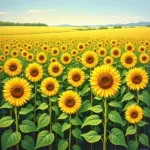Con que colores se hace el azul? This question, which translates to “what colors make blue?” is a common query for aspiring artists and curious minds alike. Surprisingly, pure blue is a primary color, meaning it can’t be created by mixing other colors. However, you can create a wide range of blues by mixing blue with other colors, or by cleverly combining other hues to achieve a blue-ish effect. Let’s dive into the fascinating world of color mixing and explore the different ways to achieve various shades of blue.
Understanding Primary Colors and Blue
Blue is one of the three primary colors, alongside red and yellow. These colors are the foundation of the color wheel and cannot be created by mixing other colors. Think of them as the building blocks of all other colors. This is why the question “con que colores se hace el azul (pure blue)” doesn’t have a direct answer involving mixing colors.
Mixing Blue with Other Colors
While you can’t make pure blue, you can certainly create numerous shades and tints of blue by mixing it with other colors. Adding white to blue creates lighter shades like sky blue or baby blue. Adding black to blue results in darker shades like navy blue or midnight blue. Mixing blue with other primary colors opens up a world of possibilities:
- Blue + Red = Violet/Purple: The intensity of the purple will depend on the ratio of blue to red.
- Blue + Yellow = Green: Again, the specific shade of green depends on the proportions of blue and yellow.
 Mixing Blue with White and Black
Mixing Blue with White and Black
Creating the Illusion of Blue
There are some interesting techniques to create the illusion of blue by using colors that aren’t traditionally associated with it. These techniques are particularly useful in digital art and printing:
- CMYK Color Model: In printing, cyan, magenta, yellow, and key (black) are used. Combining cyan and magenta in specific proportions can create a deep blue.
- RGB Color Model: Screens use red, green, and blue light to create colors. By adjusting the intensity of these light sources, different shades of blue can be achieved. In this case, blue is a primary color, but the perceived shade changes based on the intensity of the blue light.
Exploring Different Shades of Blue
The world of blue is vast and varied. From the calming serenity of cerulean blue to the vibrant energy of electric blue, there’s a shade for every mood and occasion. Understanding how these shades are created can greatly enhance your artistic skills and deepen your appreciation for the beauty of color.
“Understanding the underlying principles of color mixing allows artists to unlock a world of creative possibilities,” says renowned color theorist, Dr. Anya Sharma. “Even though pure blue can’t be mixed, exploring its interactions with other colors is a fascinating journey.”
Conclusion: Unlocking the Mystery of Blue
So, con que colores se hace el azul? While pure blue itself is a primary color and cannot be mixed, we’ve explored how mixing blue with other colors or using techniques like CMYK and RGB can help you achieve a vast spectrum of blues. Experimentation is key to mastering the art of color mixing. Don’t be afraid to play with different proportions and discover your own unique shades of blue!
FAQ
- What are the primary colors? Red, yellow, and blue are the primary colors.
- Can I make blue by mixing other colors? No, pure blue is a primary color and cannot be mixed.
- How do I make light blue? Mix blue with white.
- How do I make dark blue? Mix blue with black.
- What colors do I mix to get purple? Mix blue and red.
- What colors do I mix to get green? Mix blue and yellow.
- What is the CMYK color model? Cyan, magenta, yellow, and key (black) – a color model used in printing.
“By understanding the limitations and possibilities of each color, you can create truly impactful and expressive artwork,” adds Dr. Sharma. “Don’t be afraid to push boundaries and experiment with color!”
For support, contact us at 0373298888, email [email protected], or visit 86 Cau Giay, Hanoi. We have a 24/7 customer service team.

